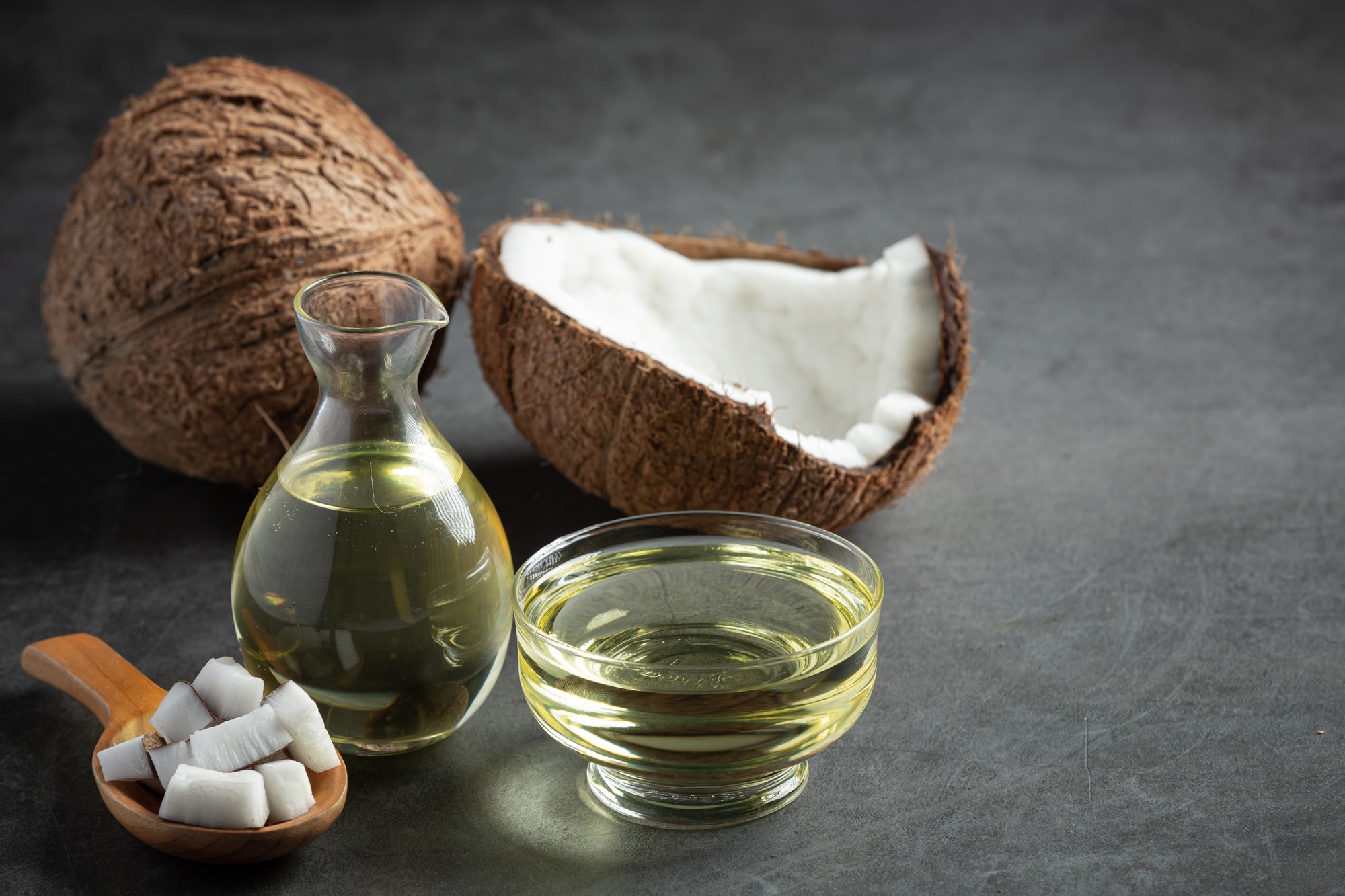Your Guide to Making Cannabis-Infused Coconut Oil
by Haley Mills · February 27, 2023
Are you looking for a unique way to infuse cannabis into your cooking? Discover the simple and delicious recipe for making cannabis-infused coconut oil!

Cannabis oil is trendy in both recreational and medicinal cannabis settings. Often characterized by its high potency, marijuana-infused oil can be used for conditions that need exceptionally high strength, such as cancer treatment. Critics of cannabis oil consider this marijuana addictive, primarily because of the tolerance build-up that occurs with frequent use.
Cannabis oil may be suitable for cancer treatment but should be monitored, similar to smoked marijuana, for adverse effects and potential drug abuse, though uncommon.
What Is Cannabis-Infused Coconut Oil and How Does It Compare to Cannabutter?
Cannabis-infused coconut oil is a non-dairy, vegan-friendly alternative to cannabutter. It’s ideal for those who are lactose intolerant or prefer plant-based ingredients. Thanks to its high saturated fat content, coconut oil binds more effectively with THC, often resulting in a more potent infusion. It’s also shelf-stable and versatile—you can use it in cooking, baking, smoothies, or even skincare. Compared to cannabutter, it offers longer storage life and broader culinary use.
What Are the Benefits of Homemade Cannabis Oil?
Homemade cannabis-infused coconut oil gives you full control over potency, ingredients, and how you use it. It’s cost-effective, flexible, and easy to tailor for both culinary and wellness needs.
- Infuse it into food: Mix it into smoothies, baked goods, or salad dressings for a simple edible option.
- Use it on your skin: Apply topically for localized relief from soreness, redness, or inflammation.
- Take it sublingually: Place drops under your tongue for quicker absorption and fast-acting effects.
- Save money: Making oil at home is often cheaper than buying pre-made edibles.
- Customize potency: Adjust cannabinoid strength to fit your personal wellness goals.
- Better absorption: Coconut oil’s healthy fats improve the absorption of THC and CBD.
- Long-lasting effects: Edibles made with this oil offer extended relief, often lasting several hours.
- Supports sleep: A small dose before bed may help promote better, more restful sleep.
- Digestive health: Coconut oil’s antibacterial properties, combined with cannabinoids, may support gut balance and ease discomfort.
- Brain health: Coconut oil contains MCTs, which are thought to support cognitive function. When paired with cannabis, it may enhance neuroprotective effects.
- Customize the strength: Adjust potency to meet your needs—whether for daily use or occasional support.
Homemade cannabis oil brings all these benefits together in one easy-to-use, versatile remedy—whether you’re cooking, easing pain, or supporting overall well-being.
Potential Health Benefits of Cannabis-Infused Coconut Oil
Beyond its potency, cannabis-infused coconut oil brings a range of possible health benefits to the table:
- Antioxidant Protection: Coconut oil is rich in antioxidants, which may help protect the body from damage caused by free radicals.
- Cancer Support: Emerging research suggests cannabis may help slow the growth of certain cancer cells, making cannabis oil a potential complementary option for those undergoing cancer treatment.
- Digestive Health: Consuming cannabis-infused coconut oil might offer relief for digestive disorders like IBS or Crohn’s disease. Coconut oil’s natural antibacterial properties can also contribute to a healthier gut environment.
As always, it’s important to consult with a healthcare professional before using cannabis oil, especially for medical conditions. Start with small amounts and pay attention to how your body responds
Why Choose Cannabis-Infused Coconut Oil for Digestive Wellness?
Cannabis-infused coconut oil may support digestive wellness by combining the gut-friendly properties of coconut oil with the anti-inflammatory potential of cannabinoids. Coconut oil helps manage harmful bacteria in the digestive tract, while cannabis may offer relief for conditions like IBS and Crohn’s. Together, they can promote balance in the gut and reduce inflammation—making this infusion a gentle, plant-based option for digestive support.
How Edibles Compare to Smoking or Vaping
Cannabis edibles offer a unique experience compared to smoking or vaping. One of the most significant differences is how long the effects last. While inhaled cannabis often wears off within one to two hours, edibles can provide relief that lasts for four to eight hours or more, depending on dosage and individual metabolism.
Edibles are also a smoke-free and discreet option. There’s no smell, no need for devices, and they’re easy to incorporate into daily routines—whether in the form of infused coconut oil, baked goods, or sublingual drops.
Key advantages of edibles over smoking or vaping:
- Longer-lasting effects: Ideal for managing chronic conditions or providing sustained relaxation.
- No smoke or odor: A lung-friendly option without the lingering smell of cannabis.
- Efficient dosing: Even small amounts of infused oil can go a long way, making it a budget-friendly method.
Whether you’re easing discomfort or simply exploring cannabis in your wellness routine, edibles made with cannabis-infused coconut oil are a practical and lasting alternative.
Can Cannabis Coconut Oil Support Brain Health?
Cannabis coconut oil may offer cognitive benefits thanks to its unique combination of cannabinoids and medium-chain triglycerides (MCTs). MCTs, found in coconut oil, are known to provide a quick energy source for the brain and may support mental clarity. When infused with cannabis, this oil delivers cannabinoids like CBD and THC in a way that could enhance their potential neuroprotective effects.
Some early research and anecdotal reports suggest this combination may help support brain health and could be of interest to those exploring natural options for aging, memory, or focus. While more scientific studies are needed, many people include cannabis coconut oil in their wellness routines as a gentle, plant-based supplement for cognitive support
How can I use cannabis oil?
Cooking cannabis has become a massive trend among restaurant entrepreneurs, chefs, and recipe and food styling businesses. The Food Innovation Group, including top brands such as Bon Appetit and Epicurious, has featured many cannabis dishes, chefs, and restaurants in the past few years. The cannabis food industry will become more relevant as legal access grows. You can use it to marinate meats, sauté veggies, roast potatoes, make a salad dressing, and more.
How to Dose and Estimate Potency
Finding the right cannabis oil dosage depends on a few factors—especially the potency of your flower and how much your body absorbs.
Start Low and Go Slow
For beginners, it’s best to start with a small amount—about one teaspoon or a single dropper of oil. Wait at least 1 to 2 days before increasing the dose, especially if you’re new to edibles or using a new strain.
Estimating Potency Based on THC %
To estimate how strong your infusion might be, begin with your cannabis flower’s THC percentage. Most strains average around 15% THC.
- 1 gram of flower = 1000 mg
- At 15% THC = up to 150 mg THC per gram
- Actual absorption = 30–70%
Realistically, expect to extract around 50–100 mg of THC per gram depending on your infusion method.
Calculating a Batch
Determine how much THC you want in each serving, then multiply that by the number of servings in your recipe.
Example: If you want 10 mg of THC per brownie and you’re making 9 brownies, your batch should contain 90 mg total THC. That means you’ll need about 1 to 2 grams of cannabis (at 15% THC) to meet that target, factoring in some loss during infusion.
Pro tip: It’s easier to dilute an infusion that’s too strong than to try to strengthen a weak one. You can always add more coconut oil later to reduce potency.
How to Calculate Potency of Homemade Cannabis Coconut Oil
To estimate potency, you’ll need to know the THC percentage of your cannabis flower—15% THC is a common average. One gram of flower at 15% THC contains up to 150mg of THC. However, due to varying extraction efficiency, only 30–70% of the THC typically makes it into your oil.
For most home infusions, expect around 50–100mg of THC per gram of cannabis used. To calculate the dosage per serving, multiply your desired dose (e.g., 10mg) by the number of servings (e.g., 10 cookies = 100mg total). Then adjust the amount of cannabis you use to match that target.
Planning Your Edibles
Decide how strong you want each edible. Beginners often start with 5–10mg of THC per serving. Multiply your desired dose by the number of servings to find the total THC needed.
Example: For 9 brownies at 10mg each, you’ll need around 90mg total—about 1 to 2 grams of cannabis at 15% THC.
Tip: If your batch turns out stronger than expected, you can always dilute it by adding more coconut oil. It’s easier to weaken the potency than to increase it later.
Choosing the Right Oil Base
When it comes to cannabis infusion, the oil you choose plays a major role in potency and absorption. Coconut oil and olive oil are the most popular options, but coconut oil remains the favorite, especially for baking and long-lasting edibles.
Why Coconut Oil Works Best
Coconut oil is high in saturated fats, particularly medium-chain triglycerides (MCTs), which bind well with cannabinoids like THC and CBD. These compounds are fat-soluble, meaning they need a fat-rich carrier to be efficiently absorbed by the body. Coconut oil’s unique composition helps maximize absorption and makes your edibles more potent and longer-lasting.
This is why cannabis coconut oil is a staple in homemade edibles—from brownies to salad dressings to infused wellness oils.
Unrefined vs. Refined Coconut Oil
- Unrefined coconut oil has a rich coconut aroma and works well when you want that tropical flavor in your recipe.
- Refined coconut oil has a more neutral taste, making it better for general cooking or recipes where you don’t want added flavor.
Other Oils for Infusion
- Olive oil: Great for savory recipes and heart-healthy, olive oil is also effective for infusion, though with slightly lower fat content than coconut oil.
- Vegetable oil: This can be used in a pinch but contains less saturated fat, which may reduce cannabinoid absorption and overall potency.
Why Fats Matter in Cannabis Infusion
THC and CBD bind to fat during infusion, which is why traditional edibles like cookies, brownies, and cannabis butters are so effective. Recipes with healthy fats allow your body to absorb more cannabinoids, improving both the effects and the overall experience.
Infusion Facts
An ideal amount is to use about a quarter to a half ounce of cannabis plant material per one cup of liquid coconut oil. You can always use more or less, but this is a safe ratio to fall back on, especially when starting out.
How to Ensure Consistent Potency in Each Batch of Cannabis Coconut Oil
To ensure consistent potency in each batch of cannabis coconut oil, stick to precise measurements and repeatable methods. Use a kitchen scale to weigh your cannabis and measure your coconut oil accurately, keeping the same ratio every time. It also helps to note the cannabis strain and its THC or CBD content if known. Keep a journal of your recipe details—amounts, cooking time, temperature, and results—so you can easily recreate batches that work best for you. Staying consistent with your process reduces guesswork and helps maintain reliable effects from one infusion to the next.
Why Coconut Oil Enhances Cannabis Absorption
Coconut oil is one of the best fats for infusing cannabis, and the reason is simple: it’s rich in saturated fats, especially medium-chain triglycerides (MCTs), which help cannabinoids bind more effectively during the infusion process.
Cannabinoids like THC and CBD are fat-soluble, meaning they need to be combined with fat to be properly absorbed by the body. Coconut oil provides an ideal base because its healthy fats allow for better binding during decarboxylation and cooking. As a result, cannabis-infused coconut oil often produces stronger, longer-lasting effects than oils with lower saturated fat content, such as vegetable oil.
This makes coconut oil not only a practical choice for potency but also a versatile one for both culinary and wellness applications.
Key benefits of using coconut oil for cannabis infusion:
- High saturated fat content: Improves the absorption of cannabinoids like THC and CBD.
- Mild flavor: Works well in both sweet and savory recipes without overpowering the dish.
- Versatile use: Ideal for baking, sautéing, smoothies, or even topical applications.
Choosing the right oil sets the foundation for how effective your homemade cannabis products will be. With coconut oil, you’re maximizing both potency and versatility.
Preserving Flavor and Terpenes
To make an oil that keeps the earthy, aromatic flavor of cannabis, pay attention to the terpenes. These compounds give cannabis its scent and some of its therapeutic effects, but they are heat-sensitive.
Use a low and slow infusion method like a double boiler to protect the terpenes from burning off. Keep the temperature between 220°F and 245°F (105 to 120°C), and simmer for 2 to 3 hours, stirring occasionally.
The length of your infusion also affects the final flavor. The longer your canna-oil and plant material simmer together, the more pronounced that “green” plant taste becomes. Some enjoy this earthy flavor, while others prefer a milder infusion—so if you’re sensitive to the taste, consider shortening the simmer time to keep the flavor subtle.
Also, choose an oil that complements the plant’s taste without overpowering it. Coconut, olive, or avocado oil are good options.
For best results, strain the oil well and store it in a cool, dark place to preserve its flavor and potency.
Tips and Tricks to Enhance Your Homemade Canna-Oil
Creating high-quality homemade canna-oil is both an art and a science. These tips will help you preserve potency, enhance flavor, and get the most from your infusion.
Keep Cooking Temperatures Low
To preserve cannabinoids, use low heat during infusion. Aim to stay below 284°F (140°C), with an ideal range around 248°F (120°C). After infusion, don’t cook with the oil at temps higher than 350°F (176°C). This helps protect the active compounds and improves overall effects.
Store It Properly
Light, heat, and air degrade cannabinoids over time. Store your finished oil in an airtight glass container in a cool, dark place—ideally below 70°F (21°C). When stored correctly, the oil can stay potent for 12 to 18 months.
Balance the Flavor
Cannabis contains terpenes and flavonoids that add earthy, herbal flavors. If the taste is too strong, balance it out with complementary herbs and spices in your recipe. This lets you keep the therapeutic properties while enhancing the dish.
Strain for a Cleaner Taste
Straining properly helps reduce that grassy or bitter edge. While some flavor will remain, a finer strain gives a smoother result. Try pairing the oil’s flavor with ingredients like rosemary, garlic, or lemon to round out the profile.
Which supplies do I need?
To make infused weed oil, you’ll want to have the following supplies:
- one cup of coconut oil
- seven to ten grams of cannabis buds
- Baking sheet
- Aluminum foil
- Mesh strainer
- Mason jar or airtight container
- Cheesecloth or coffee filters
- Medium saucepan (or crockpot)
- Food Scale
How to Make Coconut Cannaoil
Here, we offer a few essential steps to get you started with infusing coconut oil with cannabis.
Decarb
Raw cannabis isn’t psychoactive. It contains compounds like THCA and CBDA. You must activate these compounds through a process called decarboxylation to convert them into THC and CBD. THC and CBS are the forms your body can use more effectively.
Decarboxylation, or “decarbing,” removes a carbon group from these compounds, releasing CO₂ and converting them into their active forms. THCA becomes THC, which produces the high, and CBDA becomes CBD, which offers therapeutic benefits. This process also increases bioavailability, meaning your body absorbs the cannabinoids more efficiently.
To decarb at home, spread your cannabis on a baking sheet. Heat it in the oven at 375°F. This will create a quick and effective infusion base.
Grind
If you have ground cannabis that is too fine, you’ll end up with a green, odd-tasting weed infused coconut oil. Using a hand grinder or coarse coffee grinder for optimum results is best.
Mix
Place your cannabis and coconut oil in a mason jar and stir gently. Replace the lid to the mason jar, and screw it on tight enough to prevent outside water intrusion, but not fully sealed during the infusion process.
Simmer
Place the mason jar in room temperature water. You’ll want to make sure there’s enough water to cover the jar. Set on low and let it simmer for a minimum of 2 hours. Remember to occasionally stir or shake when making cannabis oil and such products for an even level of potency and flavors.
Strain
After simmering and slowly increasing the oil’s temperature, you must strain it. Put a few layers of cheesecloth into jars and utilize an elastic band to keep it safe during tension. You can do the same process with a coffee filter if you don’t have access to a cheesecloth.
When strained, it can easily be removed or recycled into compost, and your own cannabis coconut oil can go into a mason jar. Then, placing it in a mason jar for a few hours in the refrigerator will complete the process.
Use a cheesecloth, coffee filters, or a fine mesh strainer. Don’t squeeze the cloth to avoid excess plant matter.
Other Methods for Infusing Oil
Here are three alternative methods for making cannabis coconut oil. Depending on the type of area and supplies you have, one of these options may work better for you.
How to Infuse Cannabis Coconut Oil Using a Crockpot
Using a crockpot (slow cooker) is one of the easiest hands-off methods for making cannabis coconut oil at home. Here’s a step-by-step guide to help you do it right.
Step 1: Prep the Cannabis
Weigh and roughly break apart your cannabis flower or use coarsely ground cannabis. This helps ensure even infusion.
Step 2: Combine Cannabis and Oil
Add the cannabis and coconut oil directly to the crockpot. Stir gently to mix.
Optional: You can place the mixture in a mason jar, then set the jar inside the crockpot water bath. This keeps your setup cleaner and prevents overheating.
Step 3: Heat and Simmer
Cover the crockpot and cook on high for 1 hour to activate infusion. Then turn the heat to low and let it simmer gently for another 2 to 3 hours. Stir occasionally or gently shake the mason jar if you’re using one.
Step 4: Strain the Oil
Let the mixture cool slightly. Line a mesh strainer with cheesecloth or a coffee filter, and pour the oil through into a clean glass jar. Allow it to drain naturally without squeezing, which can add bitterness from excess plant material.
Step 5: Store It Right
Store your infused oil in an airtight glass container in a cool, dark place or the refrigerator. Proper storage helps preserve potency and flavor.
Double Boiler
First, for the double boiler method, you’ll fill the lower half with water and melt the coconut oil in the top half above your hot water pan. Then, add a cup of water to regulate the temperature at low heat. Once thoroughly mixed, add your cannabis, simmer and stir occasionally to ensure your cannabis oil doesn’t overheat.
Infusion Duration and Taste
The length of your infusion can affect both potency and flavor. Longer simmer times bring out stronger, more herbal or earthy notes in your cannabis oil. Some people enjoy this bold taste, while others may find it bitter or overpowering. If your infusion tastes too strong, try reducing the simmering time slightly in your next batch. A shorter infusion can help mellow the flavor while still preserving key cannabinoids.
How Long Does the Double Boiler Method Take?
The double boiler method is slow but effective. After you decarboxylate your cannabis and mix it with oil, the infusion takes about 6 to 8 hours on low heat. This steady temperature helps preserve cannabinoids and draw them into the oil.
After simmering, strain the oil with cheesecloth or a fine mesh strainer—this step takes another 15 to 20 minutes. In total, expect the entire process, including prep and cleanup, to take around 7 to 9 hours.
Patience pays off: the slow infusion results in a potent, high-quality canna oil.
Sous vide
The method for sous vide cannabis oil is an excellent choice for those wanting to release as slight an odor as possible if you live in an apartment complex with your parents or want to discreetly; this method will work for you.
With the sous vide method, you’ll still begin by coarsely grinding the plant matter with a hand or coffee grinder and placing them in a heat-proof, vacuum-sealed bag. After that, place a large pot on the stovetop and fill it with water. Once the water has reached 230 degrees Fahrenheit, place your sealed bag of buds in hot water and cook for an hour and a half; then, you’ll infuse coconut oil as the last step.
How to Store Cannabis Coconut Oil
Store your infused oil in a sealed glass container, like a mason jar, in the fridge or in a cool, dark place. Avoid exposing it to light, heat, or air, as these can break down cannabinoids over time.
If your home stays below 70°F, room temperature is fine. Just make sure to keep the oil away from sunlight and temperature changes.
Strain the oil thoroughly to remove any plant matter. This helps prevent mold and spoilage.
When stored correctly, cannabis coconut oil can last up to 12 to 18 months. However, potency may start to decline after three to six months.
Wrapping it Up
There are a large variety of cannabis-infused products on the market today. When purchasing or buying cannabis oil, choosing trusted brands with high-quality ingredients is essential.
Always check your local cannabis laws before purchasing or using cannabis to make oil at home.
Leafy DOC is happy to assist in your search for the best strains and brands to ensure you are able to make cannabis coconut oil at a high quality.
Frequently Asked Questions
How is Canna Oil Different from CBD Oil?
Canna oil contains high THC and can get you high. CBD oil has barely any THC, so it won’t produce psychoactive effects.
Should I Use Hemp or Marijuana to Make Cannabis Oil?
Hemp is legal in more areas and won’t get you high. High in CBD, this product is best for those seeking relaxing effects without THC. Marijuana has more THC and stronger effects, but it may not be legal in your state. People often prefer it for therapeutic use if they need higher potency.
Should I Add Lecithin to My Cannabis Oil?
Yes. Lecithin helps cannabinoids bind better with oil, improving texture, shelf life, and absorption in the body. This makes your cannabis oil more effective and easier to use in recipes. Sunflower lecithin works for most diets. Eggs also contain lecithin and are useful in baked edibles.
Is It Safe to Consume CBD Coconut Oil?
Yes, CBD coconut oil is generally safe to consume when made with lab-tested CBD and organic coconut oil. Start with a small amount to see how your body responds—especially if you’re new to CBD. Some people may experience mild effects like dry mouth or drowsiness. If you’re on medication or have health conditions, consult your healthcare provider first. Safe sourcing and slow dosing are key to a positive experience.
Is CBD-Infused Coconut Oil Safe to Consume?
CBD-infused coconut oil is generally considered safe as long as it’s made with quality ingredients and prepared properly. Start with a small amount to see how your body responds, especially if you’re new to CBD. Be sure to use high-quality, lab-tested CBD and pure, food-grade coconut oil to avoid unwanted additives or contaminants. As with any supplement, consult with your healthcare provider if you have concerns or underlying health conditions.
Last Updated: July 7, 2025
Get Approved for Your Medical Marijuana Card in Minutes!

Get Your Medical Card
Connect with a licensed physician online in minutes

Like This Article?
Share with your friends
Table of Contents
Keep Reading
-
Why Are My Weed Plants Turning Yellow?
Is your weed plant turning yellow? Learn the ultimate solution to vibrant green marijuana plants and how to fix it now! Don’t miss out on this must-read guide. Click here for expert tips!
-
Step-by-Step Guide for Arkansas Medical Marijuana Card Renewal
Simplify your Arkansas medical marijuana card renewal with this comprehensive step-by-step guide.
-
Medical Marijuana and Epilepsy: A Review of the Latest Research
Explore the latest research on medical marijuana and epilepsy and discover how it can be used to manage seizures. Learn about the potential benefits and risks of using cannabis for epilepsy



